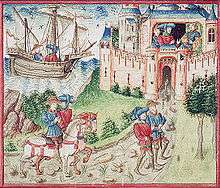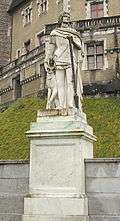Gaston III, Count of Foix

Gaston Fébus [or Phoebus] (30 April 1331 – 1391) was the eleventh count of Foix (as Gaston III) and viscount of Béarn (as Gaston X) from 1343 until his death.
Early life
Gaston was born either in Orthez or Foix, the son of Gaston II/IX (1308–1343). His native language was Gascon (a dialect of Occitan), but he was also fluent in French. He wrote a treatise on hunting in French, and an Occitan song, Se Canta, has been ascribed to him. One contemporary records that he "very willingly spoke to me not in his native Gascon but in proper and elegant French".[1]
Count of Foix
Béarn had passed to the county of Foix in 1290. Gaston paid homage to the French king for his own county, but starting in 1347 he refused to give homage for Béarn, which he claimed as an independent fief, with its chief seat his stronghold at Pau, a site that had been fortified by the 11th century, which was later made the official capital of Béarn in 1464.
He was succeeded as count of Foix by Mathieu of Foix-Castelbon.
A fortune won in battle
The house of Béarn-Foix was engaged in a long running feud with the family of D'Armagnac. In 1362, a battle was fought between the two sides at Launac. Gaston Fébus was victorious and succeeded in capturing his chief rivals, whom he ransomed for a vast fortune of at least 600,000 florins. This money was stored in the Moncade tower in Orthez, where Fébus also created a gallery of portraits and military trophies to commemorate the event.[2]
Records of Jean Froissart

In the 1380s, Jean Froissart visited the County of Foix. He recorded the splendor of the court of Orthez under Gaston Fébus in the latter half of the 14th century. Gaston recorded the three "special delights" of his life as "arms, love and hunting"; he wrote an important treatise on the latter entitled Livre de chasse. [3]
Livre de chasse (Book of the Hunt)
Gaston was one of the greatest huntsmen of his day, and hunted his entire life – he died of a stroke while washing his hands after returning from a bear hunt. His Livre de chasse (Book of the Hunt) was written between 1387 and 1388. It was dedicated to Philip the Bold, Duke of Burgundy. Recorded in the book are different stages of hunting different animals, as well as describing animal behavior, offering advice to less well-off gentry about how to enjoy hunting without bankrupting themselves, and is even sympathetic to the peasant poacher because he too has the hunting instinct. It is the classic treatise on Medieval hunting, and noted for one manuscript which has exquisite miniatures, illustrating the hunt.[4]
Marriage and children
Gaston Phoebus married Agnès of Navarre (1334–1396), daughter of Joan II of Navarre and Philip III of Navarre in 1348. They had a son:
- Gaston ( -1382), married Béatrice d'Armagnac (1362-1410), daughter of John II of Armagnac.
Betrayal of the Count's son

As Jean Froissart recorded, Gaston Phoebus's son Gaston betrayed him. Gaston tried to poison his father using a powder that he got from King Charles II of Navarre. Gaston was caught and imprisoned by his father. Later on, Gaston was accidentally stabbed and killed by his father during a quarrel.[5] After Gaston died, Gaston Phoebus had no legitimate heir. In 1393, in Paris at a masquerade given by the Queen of France, Isabeau of Bavaria, one of Gaston Phoebus's four recorded illegitimate sons, Yvain de Foix, was burned to death when his costume caught fire from a torch. The other performers died as well. This masquerade came to be known as the Bal des Ardents.[6]
See also
Notes
- ↑ Paul Cohen, "Linguistic Politics on the Periphery: Louis XIII, Béarn, and the Making of French as an Official Language in Early Modern France", When Languages Collide: Perspectives on Language Conflict, Language Competition, and Language Coexistence (Ohio State University Press, 2003), pp. 165–200, at 189 n. 40.
- ↑ Fowler, Kenneth (2001). Medieval Mercenaries: Vol. I The Great Companies. Oxford: Blackwell. pp. 61–7. ISBN 0631158863.
- ↑ Klemettilä, Hannele (2015). Animals and Hunters in the Late Middle Ages. Evidence from the BnF MS fr. 616 of the Livre de chasse by Gaston Fébus. New York: Routledge. ISBN 978-1-13-884233-5.
- ↑ http://medieval.library.nd.edu/facsimiles/daylife/chasse.html
- ↑ Barbara Tuchman, A Distant Mirror, pps.360-61
- ↑ Barbara Tuchman, A Distant Mirror, pps. 530-32
References
- Barbara W. Tuchman . A Distant Mirror: The Calamitous 14th Century (Paperback). Publ. Published on May, (2001), by Wayne A. Smith ISBN 9780345289308.
- Hannele Klemettilä . Animals and Hunters in the Late Middle Ages. Evidence from the BnF MS fr. 616 of the Livre de chasse by Gaston Fébus. New York: Routledge 2015. ISBN 978-1-13-884233-5.
- John Cummins . The Hound and the Hawk: The Art of Medieval Hunting Publ. Weidenfeld & Nicolson; New paperback edition (18 Jan 2001) ISBN 978-1842120972
- Febus Avant! Music at the Court of Gaston Febus, Count of Foix and Bearn (1331-1391); Huelgas Ensemble, Paul Van Nevel; Sony, 1992.
| Wikimedia Commons has media related to Gaston III of Foix-Béarn. |
| Preceded by Gaston III (IX) |
Count of Foix Viscount of Béarn 1343-1391 |
Succeeded by Matthew |
|}